It is hard to look past the astonishing job which Roberto D’Aversa has carried out this season with Parma. The Italian, arguably one of the most underrated managers in Europe, has led the Ducali to their current position of ninth place in Serie A and impressed with his pragmatic philosophy, making his side extremely tough to beat.
D’Aversa, who took over late in 2016, is now the third longest-serving manager in Serie A. The Italian has guided Parma out of Lega Pro, Serie B and earned Parma a promotion back to the top tier of Italian football.
The Gialloblu have improved on last season’s performances and are likely to finish above the 14th place, achieved in 2018/19 as the side continue their development under D’Aversa.
In the following tactical analysis, we examine Parma’s attacking and defending tactics in the Italian top flight and explain the key concepts of D’Aversa’s side.
Tactical systems
Throughout the 2019/20 season Parma mainly deployed a 4-3-3 system, starting 52% of Serie A games in this formation. However, as the game developed D’Aversa often could be found operating a 4-2-3-1, 5-4-1 or a 4-1-3-2 depending on whether he was looking to plug the holes and hold onto a lead or look for a late equaliser.
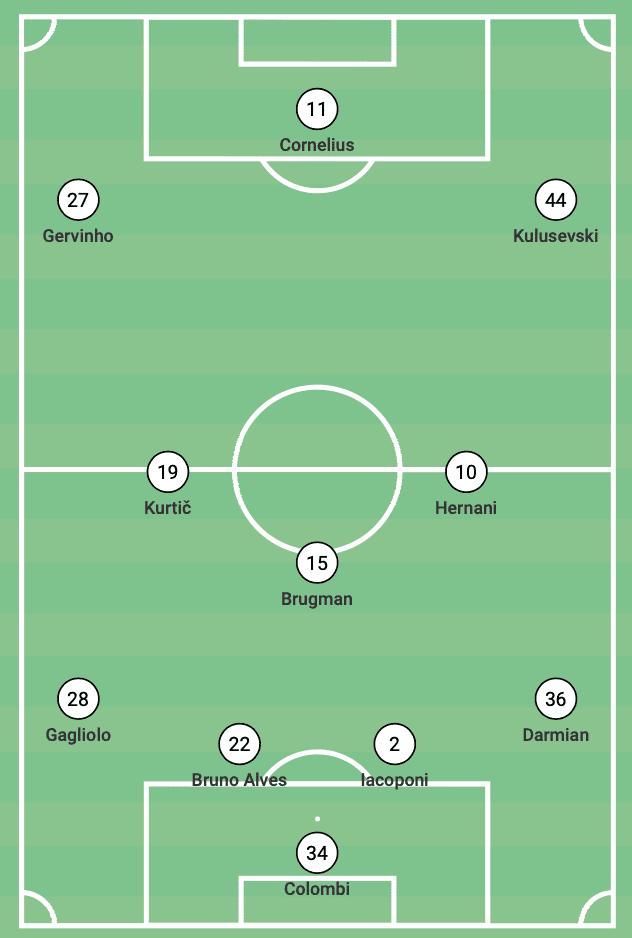
In order to gain an understanding of the type of team we are looking at under Roberto D’Aversa I would like to start by forming an understanding of Parma’s statistical output over the 2019/20 season.
Starting with expected goals (xG) and expected goals against (xGA), comparing them to goals scored and conceded. Currently, Parma are sitting on 30.7xG and have scored 32 goals. This means they are slightly overperforming their xG by 1.3 goals, managing to convert opportunities created roughly in line with the expectations. However, Parma have an xGA of 42.1 compared with 31 goals conceded. It is here under D’Aversa that Parma are significantly overachieving their xGA by 11.1 goals, conceding a significant amount less than they should have expected, which cannot be purely down to luck, some credit has to be given to Parma and the defence for blocking shots or their goalkeeper for pulling off some crucial saves.
In terms of understanding team style, it is also of interest noting that Parma are only averaging 42.7% possession so far this season, the second-lowest in Serie A.
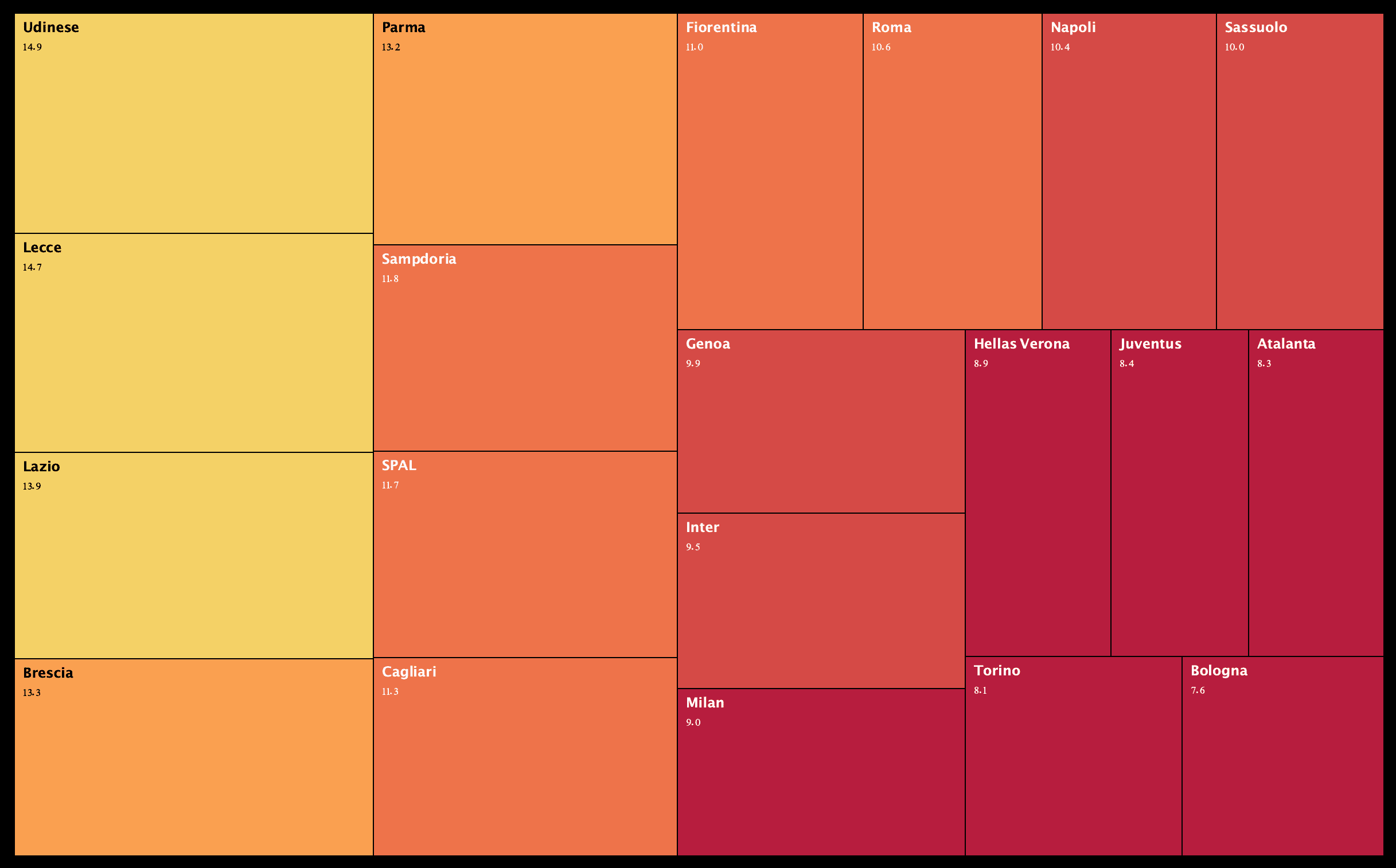
They have, a passes per defensive action (PPDA) of 13.2, one of the highest in Serie A, which highlights that D’Aversa has a preference for Parma to defend closer to the goal allowing the opposition to play a higher number of passes in the attacking half before attempting to recover the ball.
We will cover this preference in the next section, adding context as to why Roberto D’Aversa prefers his side to defend from a deeper position on the field.
Defensive phase
Parma currently have the fifth-best defensive record in Serie A, conceding a total of 31 goals in their 25 league games so far this season. One of the reasons for Parma’s defensive success under Roberto D’Aversa may have been the team’s general defensive shape, adopting an extremely compact defensive block, forcing the opposition to play a direct game.
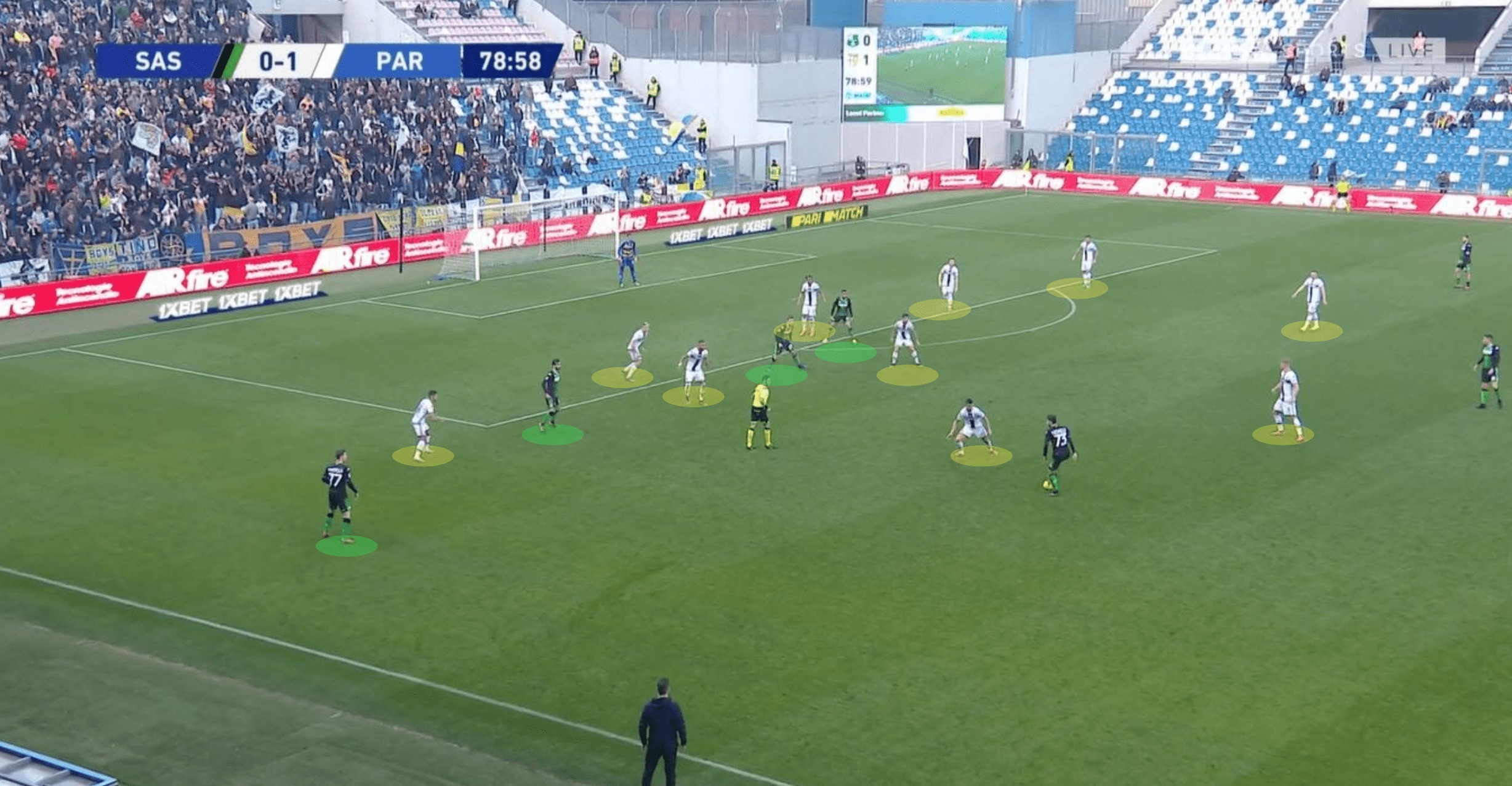
The Gialloblu can often be found adopting a 5-4-1 in the defensive phase, dropping their two wide players into a midfield line of four and allowing a midfielder to join the first line of the defensive block. We can see an example of Parma assuming this defensive shape in the image above.
Parma have four players in the first line of the defensive block and two players from the second block all situated across the three middle vertical channels. Their defensive shape is extremely compact, making it difficult for the opposition to locate a free passing lane within this space, due to the overload which favours the defence (6v3).
Parma are attempting to force Sassuolo to build their attack from a wide position, only choosing to press their opponents when they look to play the ball through a central area in the attacking third.
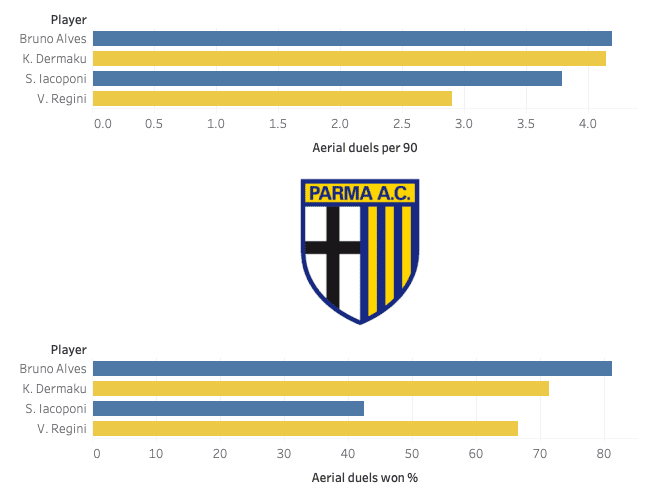
Taking a closer look at Parma’s statistics in relation to aerial duels it is clear to see why D’Aversa has adopted these tactics with his side. 38-year-old Portuguese defender Bruno Alves has the highest aerial duel success in Serie A, winning 81.3% of his duels. The above data visualization shows just how effective Parma’s centre-backs are at dealing with an aerial threat. This also adds further context in relation to Parma’s high PPDA, D’Aversa clearly instructing his side to mainly press once his team have their defensive structure set and the opponent looking to play through its core.
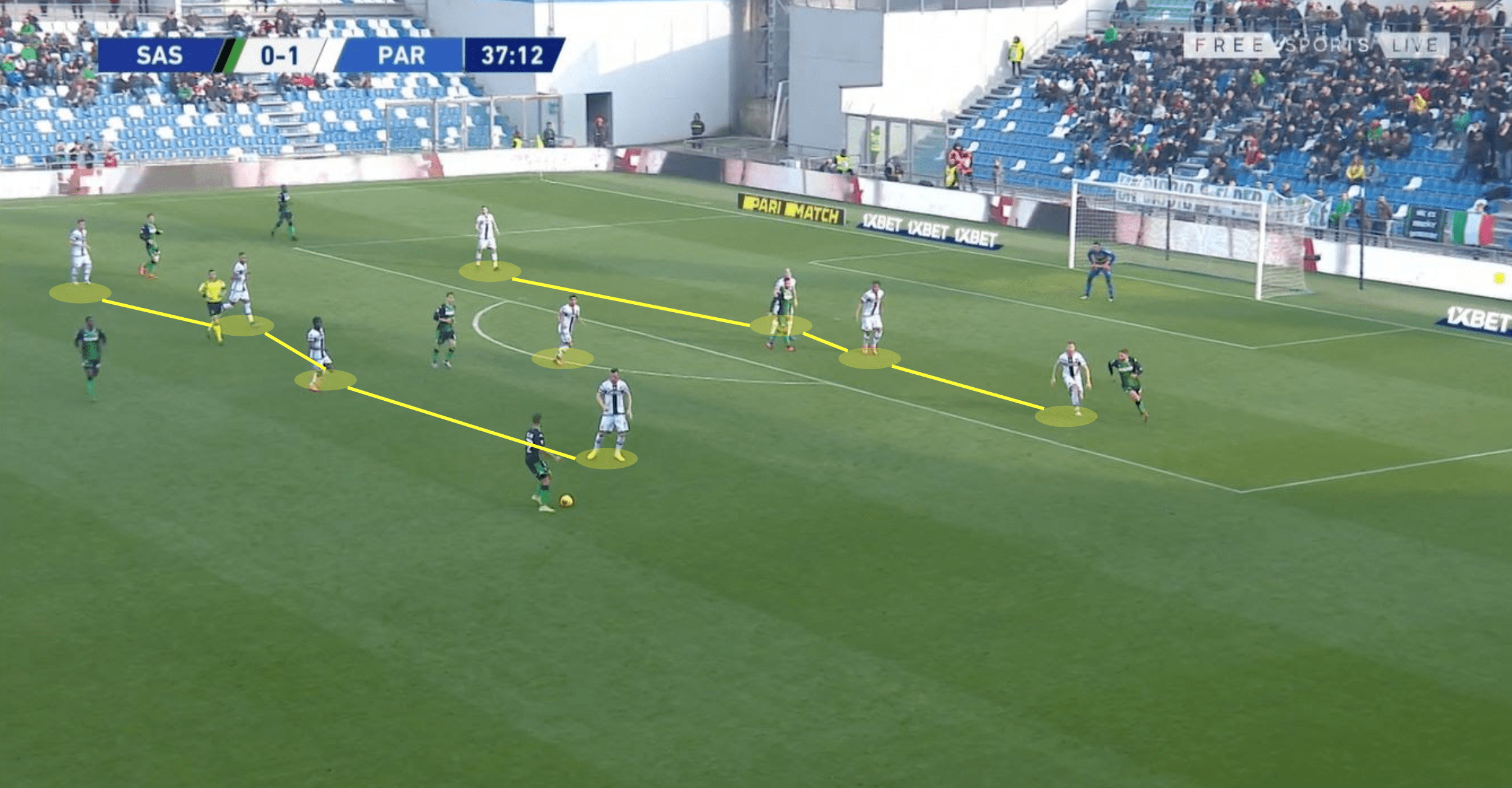
In the next image we can see another example of Parma’s defensive shape, this time adopting a 4-1-4-1 system in the defensive phase. Sassuolo are in possession of the ball, looking to progress deep into the attacking third, with their central midfielder on the ball looking for an advanced option.
The Gialloblu have again adopted a compact block in which they have ensured the opposition have no available progressive options, they also have a midfielder operating a screener between the two lines to cut off any space or pick up players looking to advance or drop between the lines to receive a pass.
Counter-attacking
Parma have scored 10 goals this season (31% of goals scored) on the counter, the highest number in Serie A. Roberto D’Aversa, despite adopting a very compact defensive shape, has the personnel to immediately progress the ball forward once regaining possession to exploit the disorganised and often over committed opposition during the transition.
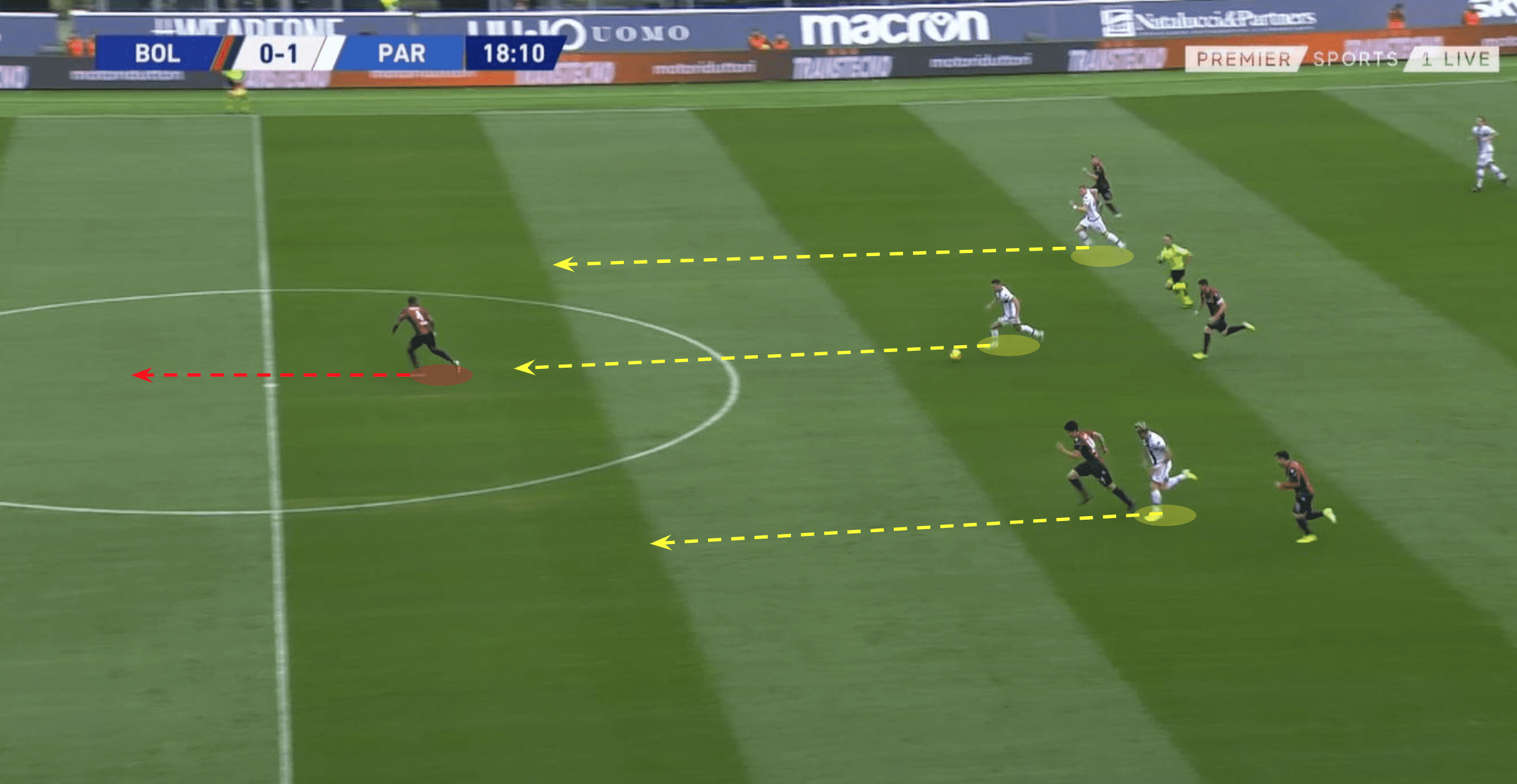
The image above provides us with a first example of how Parma have exposed Bologna via a counter-attack during the 2019/20 campaign. Bologna, who were on the attacking phase, attempted to play a cross into the Parma box, the initial header was won by Alves followed by Juraj Kucka (midfielder) winning the second ball, laying it off to Mattia Sprocati (forward).
Due to Bologna over-committing to their attacking phase, lured in by Parma’s defensive shape, the forward has one man between himself and goal. The midfield knowing how effective they can be in transition due to the explosive speed and power of individuals such as Dejan Kulusevski (on loan from Juventus), look to spring from their defensive shape to support the counter at any given opportunity, resulting in a 3v2 in the attacking third, as seen below.
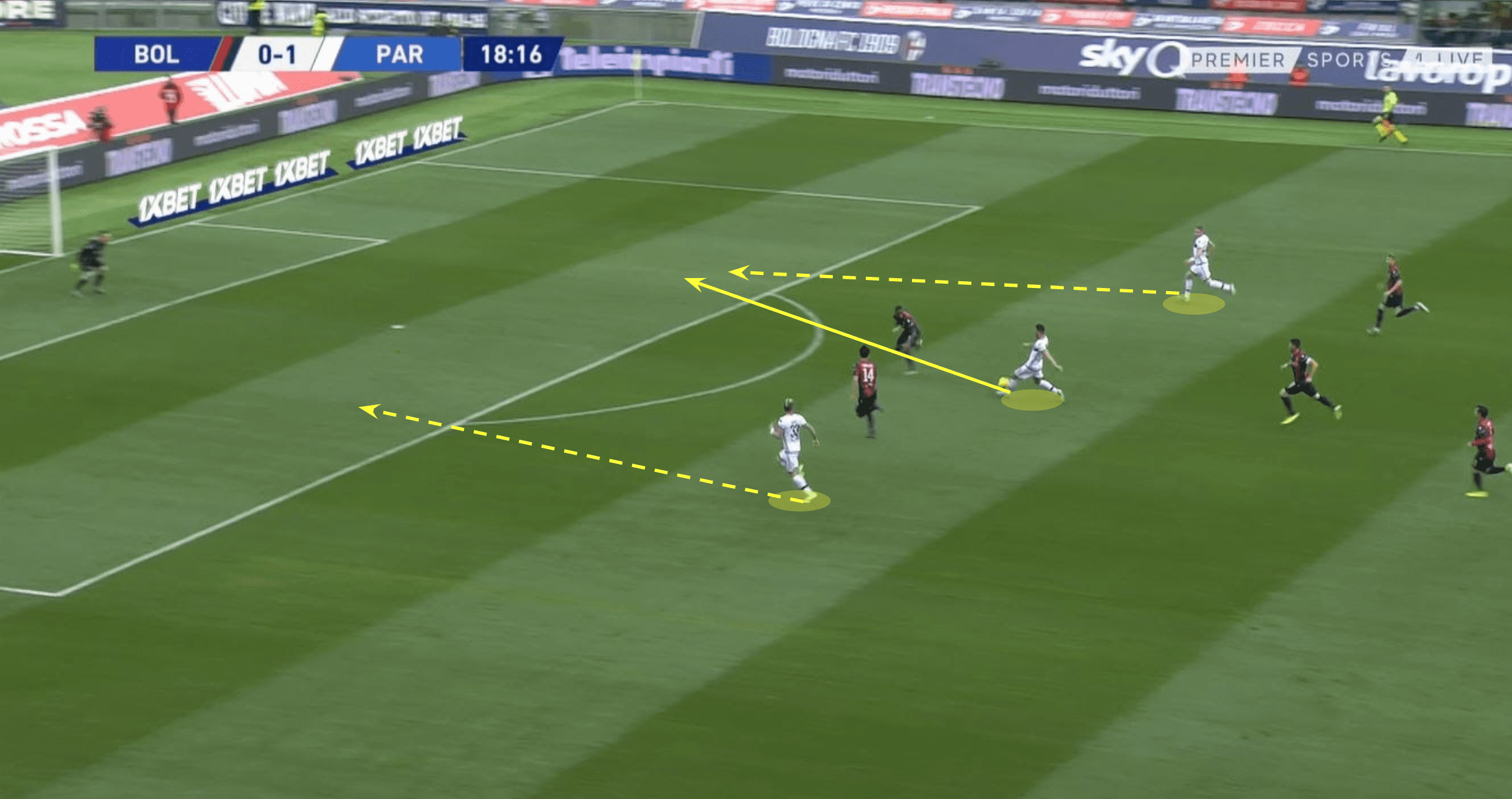
This next image shows us another example of Parma turning over possession, this time through the use of a press, to quickly transition into a counter-attack. Bologna were progressing with the ball in the middle third, an area where Parma predominantly allow the opposition time and space to progress up the pitch.
In this circumstance defender Simone Iacoponi in a man-to-man pressing system, noticed that the Bologna midfielder was receiving a pass without expecting pressure from an opponent. This pressing trigger triggered the defender to spring out of his defensive block and tackle his opposite man.
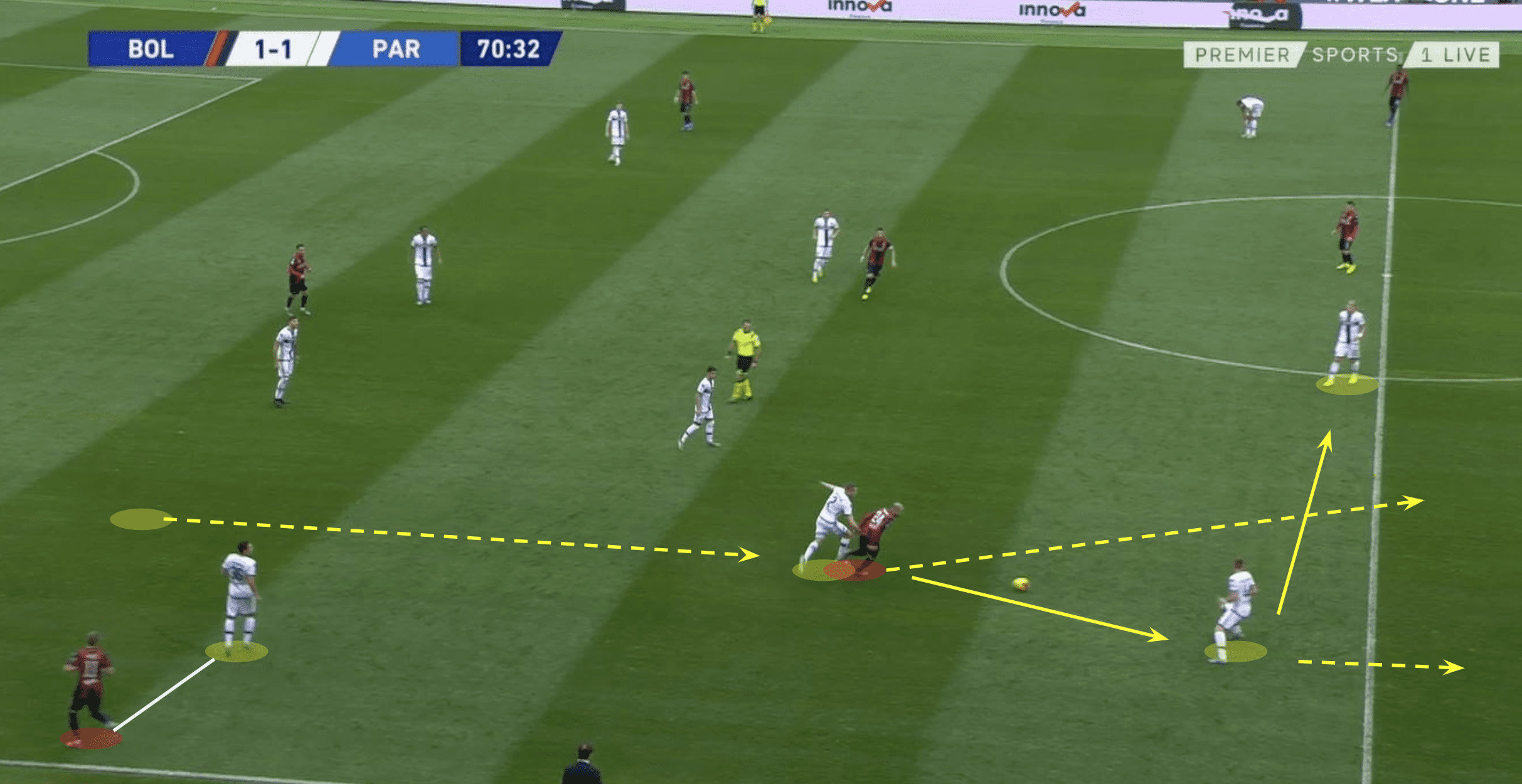
The ball fell to his team-mate Kulusevski, who laid the ball off to midfielder Kucka who drove forward with the ball, notice how Iacoponi also continued his run to support the counter, helping to force the opposition back towards their own goal.
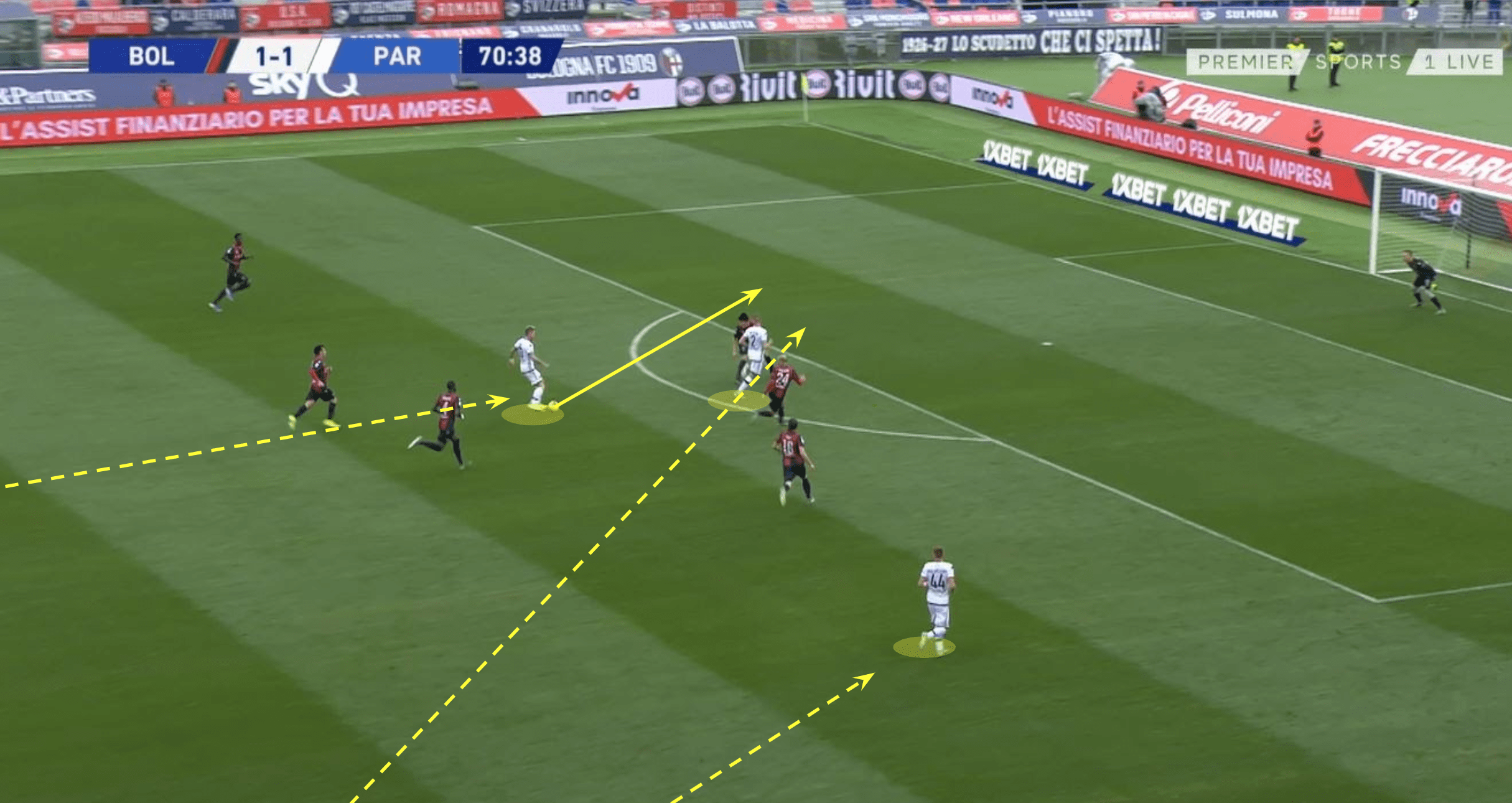
Despite there being five Bologna players between the goal and where the counter-attack initially started, Parma through Kucka were able to progress the ball to the attacking third. The supporting runs of Kulusevski and Iacoponi enabled the ball carrier to progress with the ball, forcing the defensive unit to back off to attempt to construct a block, enabling Bologna to engage in a defensive action without the risk of being isolated in a 2v1 situation.
Attacking Shape
When in the attacking phase we tend to see Parma adopt similar patterns of play to progress the ball into the attacking third. This regular occurrence under Roberto D’Aversa can be seen in the below image.
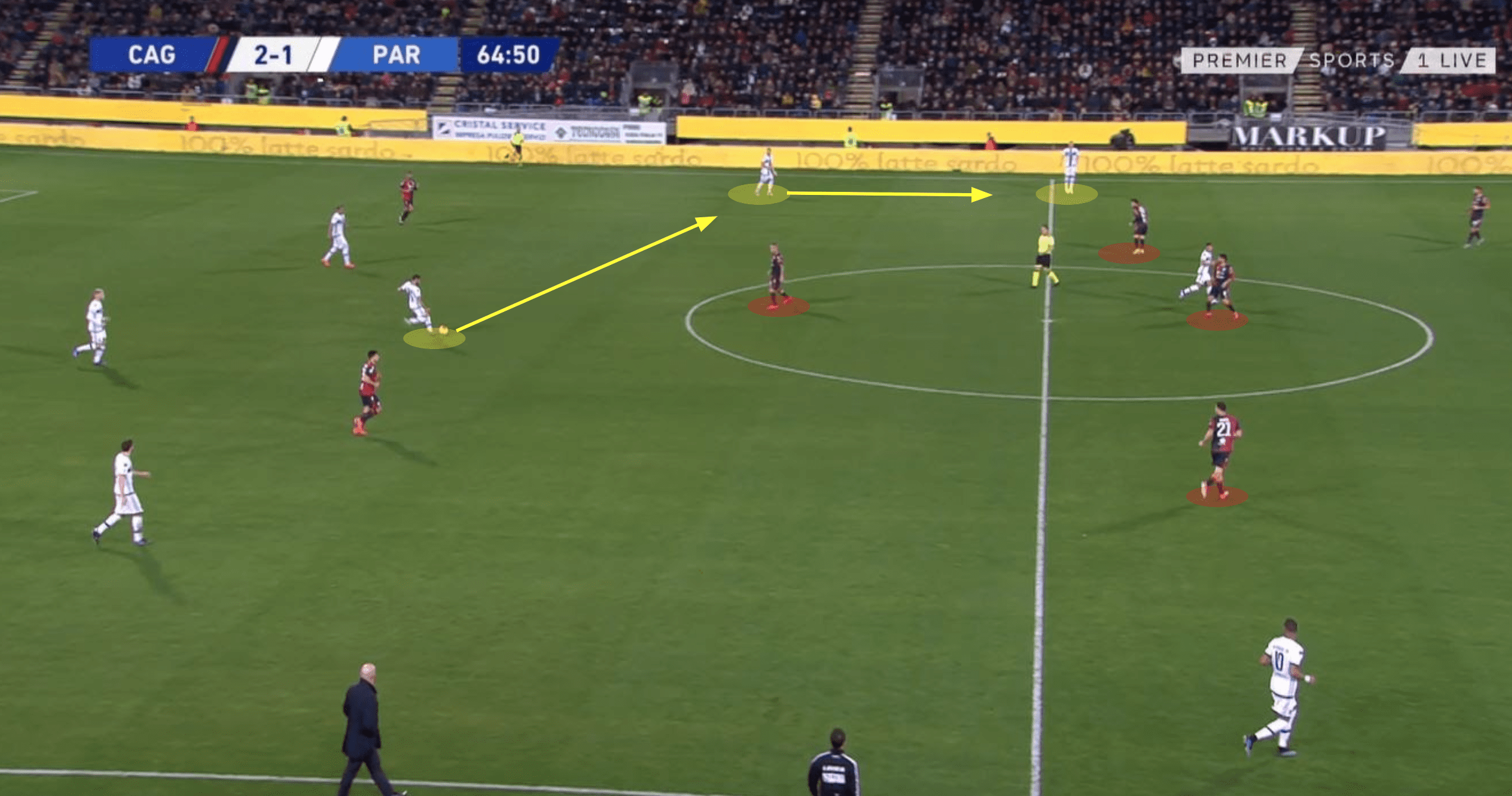
Having a midfielder drop into the role of the pivot helps to provide defensive cover for the back-line, licensing the full-backs to push on, becoming wing-backs. This simple movement enables Parma’s wide forwards the option to cut in centrally or progress the ball down the channel to the over-lapping wing-back.
This threat provides Parma with a new dimension to their attacking shape and often can be seen where the opposition operate with a deep block, congesting the middle of the pitch, as per Cagliari above. The pivot opting to play a horizontal pass out to the wide vertical channel where Parma have a numerical advantage and an easier progressive pass in space.
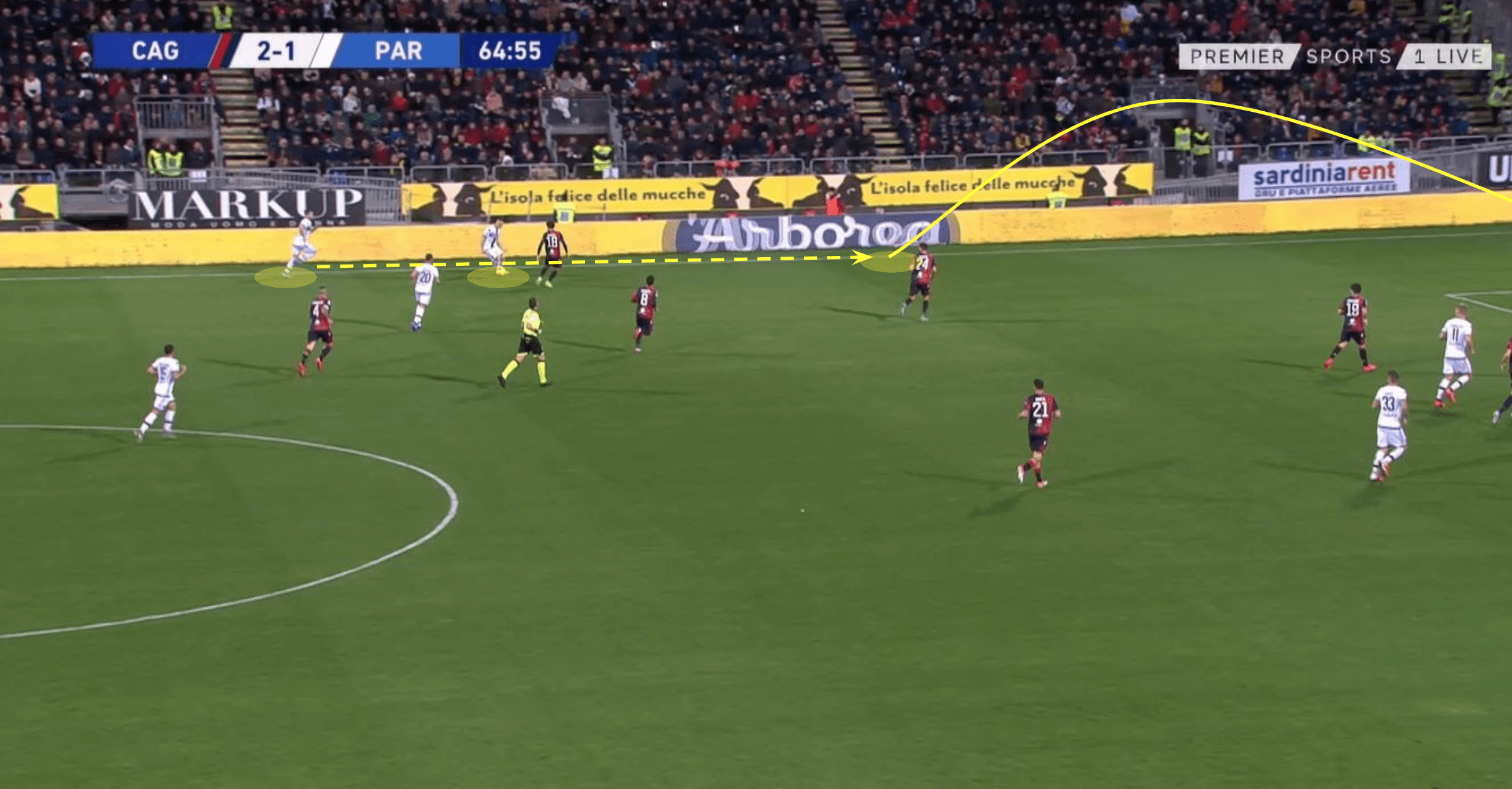
The next images shows how the initial play advanced, the threat of Kulusevski who is averaging 0.25 expected assists (xA) per 90, attracts the interest of the Cagliari press, as they look to block the wide forward from progressing into the attacking third through his direct play. This allows space for the wing-back to attack by overlapping Kulusevski, progressing play into the attacking third where Parma can look to aim a cross towards their towering forward Andreas Cornelius, who leads Serie A in relation to successful aerial duels per 90 minutes with a figure of 5.29.
Conclusion
To conclude this tactical analysis piece, it may be fair to say that under Roberto D’Aversa this season, Parma have become one of the most organised teams in Serie A. D’Aversa has managed to wring out every last drop of effort from his players who have secured 35 points to this campaign, six points off their total from last season, with 13 games still to play.
Defensively, Parma have clearly spent significant time on the training field working on their shape, their
Meanwhile, the synergy the side have when playing on the counter also credits the repetition that D’Aversa must put his squad through working on the transitional phase of the game, which has paid dividends in relation to chance creation and goals scored.
With D’Aversa being one of the longest-serving managers in Serie A, it remains to be seen whether he will be a target from one of the so-called bigger sides. Parma’s biggest challenge may well be persuading the manager that the Gialloblu can continue to build on their recent success, especially considering they may find some of their key players targeted for transfers before next season.






Comments